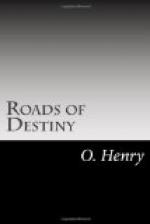Rarely has the San Saba country contributed to the spread of the fine arts. Its sons have excelled in the solider graces, in the throw of the lariat, the manipulation of the esteemed .45, the intrepidity of the one-card draw, and the nocturnal stimulation of towns from undue lethargy; but, hitherto, it had not been famed as a stronghold of aesthetics. Lonny Briscoe’s brush had removed that disability. Here, among the limestone rocks, the succulent cactus, and the drought-parched grass of that arid valley, had been born the Boy Artist. Why he came to woo art is beyond postulation. Beyond doubt, some spore of the afflatus must have sprung up within him in spite of the desert soil of San Saba. The tricksy spirit of creation must have incited him to attempted expression and then have sat hilarious among the white-hot sands of the valley, watching its mischievous work. For Lonny’s picture, viewed as a thing of art, was something to have driven away dull care from the bosoms of the critics.
The painting—one might almost say panorama—was designed to portray a typical Western scene, interest culminating in a central animal figure, that of a stampeding steer, life-size, wild-eyed, fiery, breaking away in a mad rush from the herd that, close-ridden by a typical cowpuncher, occupied a position somewhat in the right background of the picture. The landscape presented fitting and faithful accessories. Chaparral, mesquit, and pear were distributed in just proportions. A Spanish dagger-plant, with its waxen blossoms in a creamy aggregation as large as a water-bucket, contributed floral beauty and variety. The distance was undulating prairie, bisected by stretches of the intermittent streams peculiar to the region lined with the rich green of live-oak and water-elm. A richly mottled rattlesnake lay coiled beneath a pale green clump of prickly pear in the foreground. A third of the canvas was ultramarine and lake white—the typical Western sky and the flying clouds, rainless and feathery.
Between two plastered pillars in the commodious hallway near the door of the chamber of representatives stood the painting. Citizens and lawmakers passed there by twos and groups and sometimes crowds to gaze upon it. Many—perhaps a majority of them—had lived the prairie life and recalled easily the familiar scene. Old cattlemen stood, reminiscent and candidly pleased, chatting with brothers of former camps and trails of the days it brought back to mind. Art critics were few in the town, and there was heard none of that jargon of colour, perspective, and feeling such as the East loves to use as a curb and a rod to the pretensions of the artist. ’Twas a great picture, most of them agreed, admiring the gilt frame—larger than any they had ever seen.




